 4
4
EVGA SuperNOVA G2 750 W Review
Efficiency, Temperatures & Noise »Test Setup
All measurements were performed using two Chroma 6314A mainframes equipped with the following electronic loads: six 63123A [350 W each], one 63102A [100 W x2], and one 63101A [200 W]. The aforementioned equipment is able to deliver 2500 W of load, and all loads are controlled by a custom-made software. We also used a Rigol DS2072A oscilloscope kindly sponsored by Batronix, a Picoscope 3424 oscilloscope, a Picotech TC-08 thermocouple data logger, two Fluke multimeters (models 289 and 175), and a Yokogawa WT210 power meter. We also included a wooden box, which, along with some heating elements, was used as a hot box. Finally, we had at our disposal three more oscilloscopes (Rigol VS5042, Stingray DS1M12, and a second Picoscope 3424), and a CEM DT-8852 sound level meter. You will find more details about our equipment and the review methodology we follow in this article. We also conduct all of our tests at 40°C-45°C ambient to simulate the environment seen inside a typical system with a higher accuracy, with 40°C-45°C being derived from a standard ambient assumption of 23°C and 17°C-22°C being added for the typical temperature rise within a system.Primary Rails Voltage Regulation
The following charts show the voltage values of the main rails, recorded over a range from 60 W to the maximum specified load, and the deviation (in percent) for the same load range.
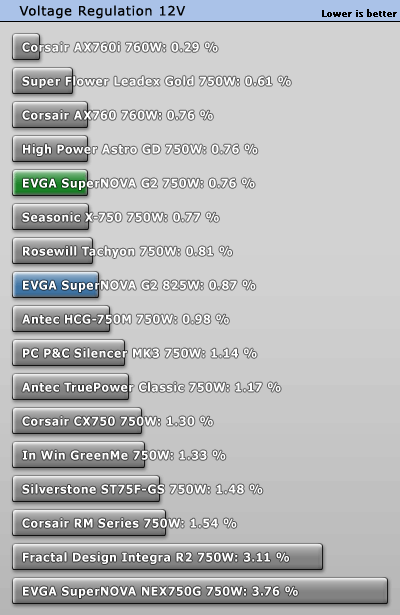

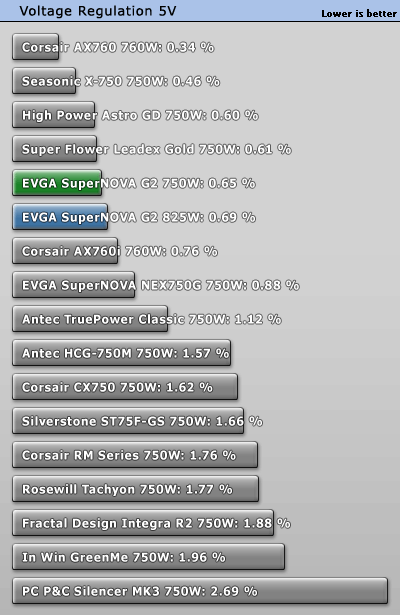

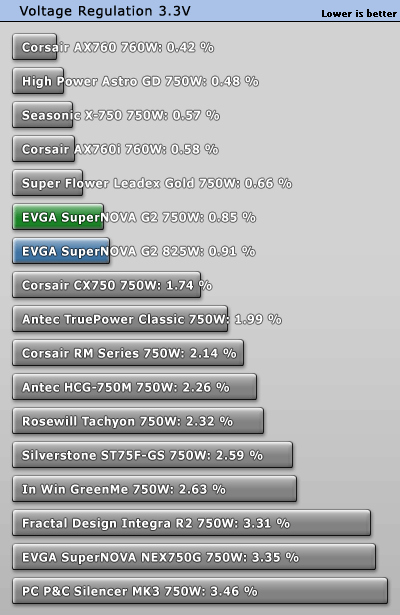
5VSB Regulation
The following chart shows how the 5VSB rail deals with the load we throw at it.

Hold-up Time
Hold-up time is a very important PSU characteristic and represents the amount of time, usually measured in milliseconds, a PSU can maintain output regulations as defined by the ATX spec without input power. In other words, it is the amount of time the system can continue to run without shutting down or rebooting during a power interruption. The ATX specification sets the minimum hold-up time to 16 ms with the maximum continuous output load. In the following screenshot, the blue line is the mains signal and the yellow line is the "Power Good" signal. The latter is de-asserted to a low state when any of the +12V, 5V, or 3.3V output voltages fall below the undervoltage threshold, or after the mains power has been removed for a sufficiently long time to guarantee that the PSU cannot operate anymore.
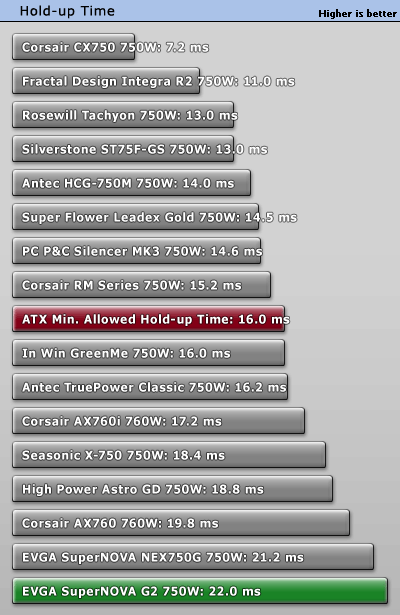
Although the G2-750 uses the exact same platform and components as the Leadex Gold 750 unit, performance in this test was very different to the Leadex unit. The Leadex Gold 750 did not reach the minimum allowed time, but the GS-750 easily passed 16 ms and even reached 22 ms! We actually made a point of desoldering both bulk caps inside the G2-750 to shed some light on this mystery, and capacity measurements confirmed that their combined capacity is in line with the official specification. We could not do the same to the Leadex unit since it wasn't at our disposal anymore and can only speculate that its bulk caps were not in their best state, although something else might have severally affected the unit's hold-up time. This is the first time we have come across such a phenomenon, but are pretty sure that it is due to the Leadex's bulk caps.
Inrush Current
Inrush current or switch-on surge refers to the maximum, instantaneous input-current drawn by an electrical device when it is first turned on. Because of the charging current of the APFC capacitor(s), PSUs produce large inrush-current right as they are turned on. Large inrush current can cause the tripping of circuit breakers and fuses and may also damage switches, relays, and bridge rectifiers; as a result, the lower the inrush current of a PSU right as it is turned on, the better.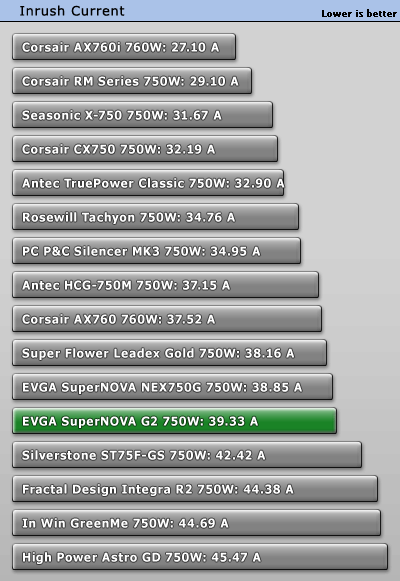
About one ampere more than the identical Leadex unit, but still under 40 A, so everything is fine here.
Voltage Regulation and Efficiency Measurements
The first set of tests revealed the stability of the voltage rails and the efficiency of the G2-750. The applied load was equal to (approximately) 20%, 40%, 50%, 60%, 80%, 100%, and 110% of the maximum load the PSU can handle.We conducted two additional tests. In the first test, we stressed the two minor rails (5V and 3.3V) with a high load while the load at +12V was only 0.10 A. This test reveals whether the PSU is Haswell ready or not. In the second test, we dialed the maximum load the +12V rail can handle while the load on the minor rails was minimal.
| Voltage Regulation & Efficiency Testing Data - EVGA G2-750 | ||||||||||
|---|---|---|---|---|---|---|---|---|---|---|
| Test | 12 V | 5 V | 3.3 V | 5VSB | Power (DC/AC) | Efficiency | Fan Speed | Fan Noise | Temp (In/Out) | PF/AC Volts |
| 20% Load | 10.549A | 1.982A | 1.994A | 0.990A | 149.77W | 90.55% | 0 RPM | 0 dBA | 49.03°C | 0.911 |
| 12.152V | 5.039V | 3.305V | 5.048V | 165.40W | 36.87°C | 230.1V | ||||
| 40% Load | 21.480A | 3.970A | 4.000A | 1.190A | 299.70W | 92.23% | 0 RPM | 0 dBA | 50.97°C | 0.966 |
| 12.130V | 5.030V | 3.298V | 5.027V | 324.95W | 37.68°C | 230.1V | ||||
| 50% Load | 26.832A | 4.969A | 5.006A | 1.596A | 374.71W | 92.14% | 810 RPM | 34.2 dBA | 41.31°C | 0.973 |
| 12.122V | 5.027V | 3.294V | 5.002V | 406.69W | 46.58°C | 230.1V | ||||
| 60% Load | 32.178A | 5.970A | 6.013A | 2.005A | 449.63W | 91.91% | 810 RPM | 34.2 dBA | 42.63°C | 0.977 |
| 12.116V | 5.023V | 3.291V | 4.978V | 489.23W | 48.25°C | 230.1V | ||||
| 80% Load | 43.094A | 7.969A | 8.034A | 2.422A | 599.57W | 91.05% | 1210 RPM | 46.7 dBA | 43.82°C | 0.983 |
| 12.095V | 5.016V | 3.285V | 4.948V | 658.50W | 50.29°C | 230.0V | ||||
| 100% Load | 54.643A | 8.983A | 9.053A | 3.058A | 749.50W | 90.00% | 1680 RPM | 47.8 dBA | 46.00°C | 0.987 |
| 12.075V | 5.009V | 3.280V | 4.903V | 832.75W | 53.80°C | 229.9V | ||||
| 110% Load | 60.910A | 8.987A | 9.059A | 3.061A | 824.38W | 89.45% | 1680 RPM | 47.8 dBA | 46.32°C | 0.988 |
| 12.062V | 5.007V | 3.278V | 4.897V | 921.65W | 54.35°C | 229.9V | ||||
| Crossload 1 | 0.097A | 14.015A | 14.005A | 0.003A | 117.64W | 83.25% | 1210 RPM | 44.5 dBA | 43.65°C | 0.894 |
| 12.166V | 5.019V | 3.292V | 5.068V | 141.31W | 49.78°C | 230.2V | ||||
| Crossload 2 | 62.455A | 1.001A | 1.003A | 1.002A | 766.81W | 90.50% | 1680 RPM | 47.8 dBA | 45.35°C | 0.987 |
| 12.064V | 5.021V | 3.291V | 5.011V | 847.30W | 52.45°C | 229.9V | ||||
The G2-750 scored pretty good efficiency for a Gold-certified unit, registering a peak of a little over 92% with typical loads.
Apr 24th, 2025 23:05 EDT
change timezone
Latest GPU Drivers
New Forum Posts
- What's your latest tech purchase? (23595)
- Have you got pie today? (16677)
- Are the 8 GB cards worth it? (177)
- pc randomly blackscreening (0)
- What are you playing? (23462)
- I dont understand the phone OS world..... (49)
- New OLED monitor makes PC unresponsive sometimes (28)
- RTX 5070ti - Which MSRP model has the better/quieter cooler design, ASUS Prime, Gigabyte Windforce or PNY? (7)
- I tried to use AMD Auto Overclock, and now my PC has been freezing up sometimes. Afterwards, the screen goes black or displays artifacts. (29)
- random system shutdown with fans running at full speed (60)
Popular Reviews
- NVIDIA GeForce RTX 5060 Ti 8 GB Review - So Many Compromises
- Crucial CUDIMM DDR5-6400 128 GB CL52 Review
- Colorful iGame B860M Ultra V20 Review
- ASUS GeForce RTX 5060 Ti TUF OC 16 GB Review
- Sapphire Radeon RX 9070 XT Pulse Review
- Upcoming Hardware Launches 2025 (Updated Apr 2025)
- Sapphire Radeon RX 9070 XT Nitro+ Review - Beating NVIDIA
- ASRock X870E Taichi Lite Review
- AMD Ryzen 7 9800X3D Review - The Best Gaming Processor
- ASUS GeForce RTX 5080 TUF OC Review
Controversial News Posts
- NVIDIA GeForce RTX 5060 Ti 16 GB SKU Likely Launching at $499, According to Supply Chain Leak (182)
- NVIDIA Sends MSRP Numbers to Partners: GeForce RTX 5060 Ti 8 GB at $379, RTX 5060 Ti 16 GB at $429 (127)
- NVIDIA Launches GeForce RTX 5060 Series, Beginning with RTX 5060 Ti This Week (115)
- Nintendo Confirms That Switch 2 Joy-Cons Will Not Utilize Hall Effect Stick Technology (105)
- Nintendo Switch 2 Launches June 5 at $449.99 with New Hardware and Games (99)
- Sony Increases the PS5 Pricing in EMEA and ANZ by Around 25 Percent (84)
- NVIDIA PhysX and Flow Made Fully Open-Source (77)
- Windows Notepad Gets Microsoft Copilot Integration (75)
